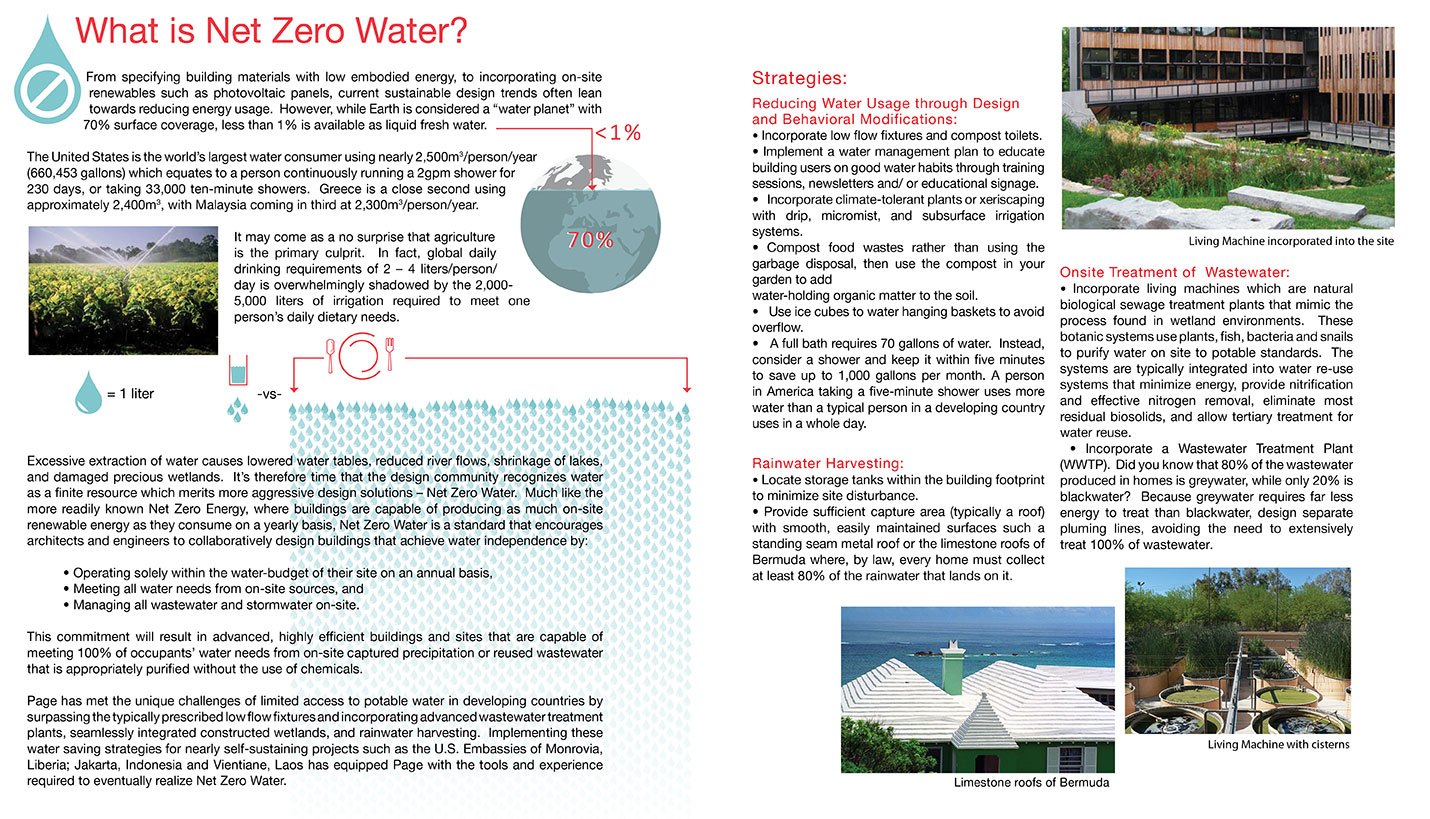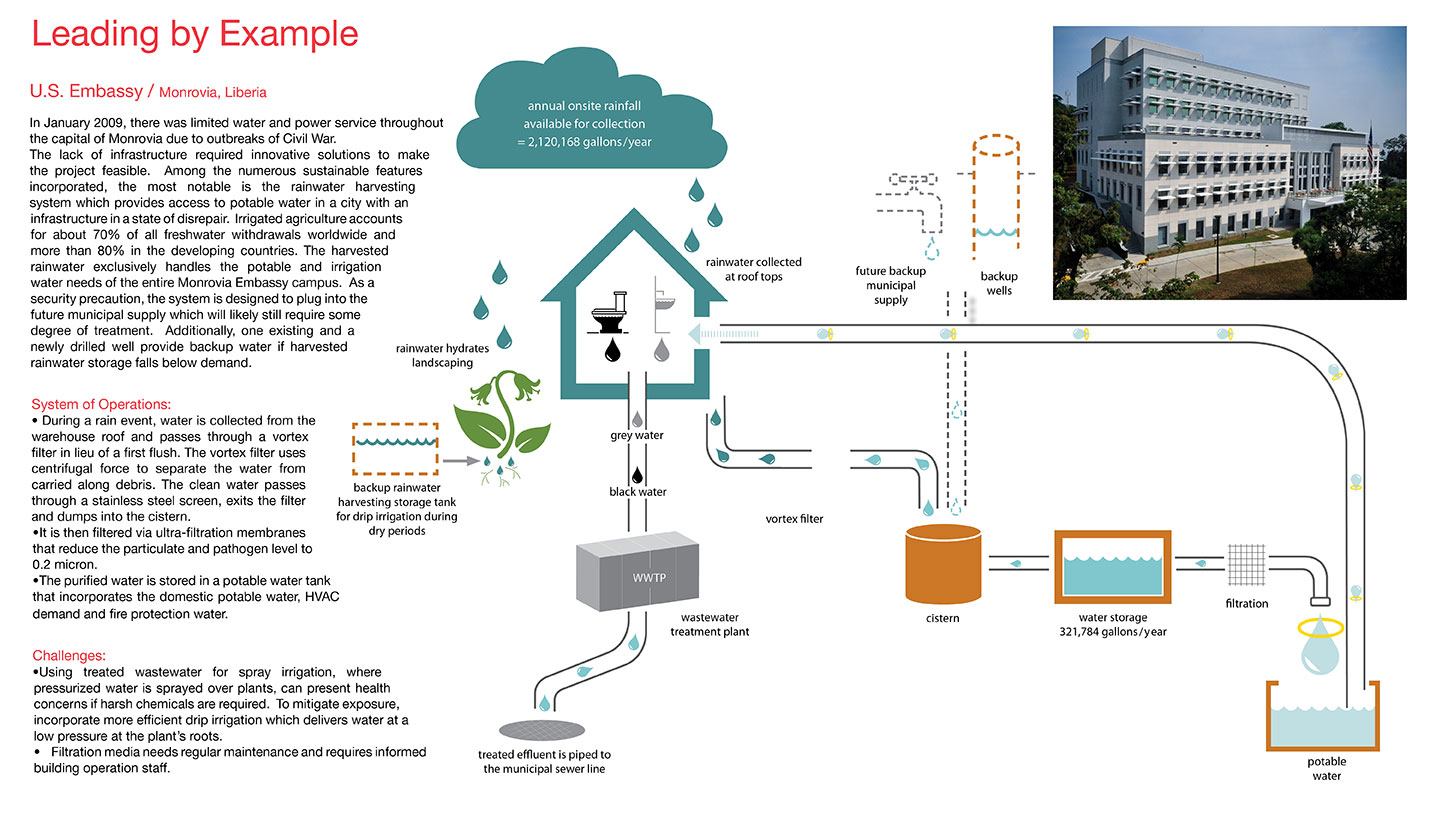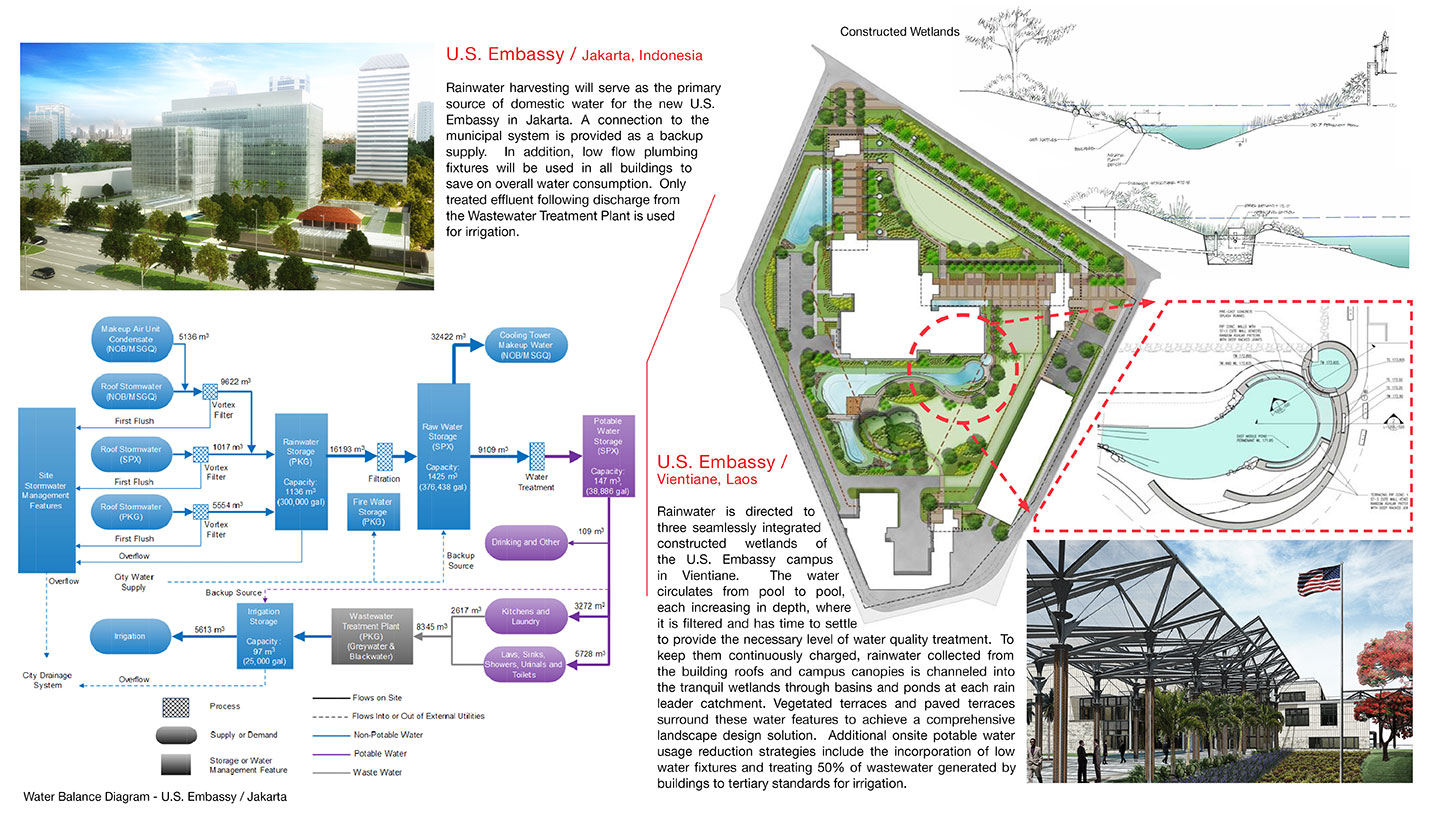Net Zero Water
While Earth is considered a “water planet” with 70% surface coverage, it might surprise you to learn that less than 1% is available as fresh water. Excessive extraction of water causes lowered water tables, reduced river flows, shrinkage of lakes, and damaged precious wetlands. Our latest Green Tip of the Month encourages the design community to recognize water as a finite resource which merits more aggressive design solutions – Net Zero Water. Much like the more readily known Net Zero Energy, where buildings are capable of producing as much on-site renewable energy as they consume on a yearly basis, Net Zero Water is a standard that encourages architects and engineers to collaboratively design buildings that achieve water independence.
What is Net Zero Water?
From specifying building materials with low embodied energy, to incorporating on-site renewables such as photovoltaic panels, current sustainable design trends often lean towards reducing energy usage. However, while Earth is considered a “water planet” with 70% surface coverage, less than 1% is available as liquid fresh water. The United States is the world’s largest water consumer using nearly660,453 gallons per person per year, which equates to a person continuously running a 2gpm shower for 230 days, or taking 33,000 ten minute showers. Greece is a close second with Malaysia coming in third. It may come as a no surprise that agriculture is the primary culprit. In fact, global daily drinking requirements of 2 – 4 liters/person/day is overwhelmingly shadowed by the 2,000-5,000 liters of irrigation required to meet one person’s daily dietary needs.
Excessive extraction of water causes lowered water tables, reduced river flows, shrinkage of lakes, and damaged precious wetlands. It’s therefore time that the design community recognizes water as a finite resource which merits more aggressive design solutions – Net Zero Water. Much like the more readily known Net Zero Energy, where buildings are capable of producing as much on-site renewable energy as they consume on a yearly basis, Net Zero Water is a standard that encourages architects and engineers to collaboratively design buildings that achieve water independence by:
- Operating solely within the water-budget of their site on an annual basis,
- Meeting all water needs from on-site sources, and
- Managing all wastewater and stormwater on-site.
This commitment will result in advanced, highly efficient buildings and sites that are capable of meeting 100% of occupants’ water needs from on-site captured precipitation or reused wastewater that is appropriately purified without the use of chemicals.
Among the most successful strategies to achieve Net Zero Water include:
Reducing Water Usage through Design and Behavioral Modifications
- Incorporate low flow fixtures and compost toilets.
- Implement a water management plan to educate building users on good water habits through training sessions, newsletters and/ or educational signage.
- Incorporate climate-tolerant plants or xeriscaping with drip, micromist, and subsurface irrigation systems.
- Compost food wastes rather than using the garbage disposal, then use the compost in your garden to add water-holding organic matter to the soil.
- Use ice cubes to water hanging baskets to avoid overflow.
- A full bath requires 70 gallons of water. Instead, consider a shower and keep it within five minutes to save up to 1,000 gallons per month. A person in America taking a five-minute shower uses more water than a typical person in a developing country uses in a whole day.
Rainwater Harvesting
- Locate storage tanks within the building footprint to minimize site disturbance.
- Provide sufficient capture area (typically a roof) with smooth, easily maintained surfaces such a standing seam metal roof or the limestone roofs of Bermuda where, by law, every home must collect at least 80% of the rainwater that lands on it.
Onsite Treatment of Wastewater
- Incorporate living machines which are natural biological sewage treatment plants that mimic the process found in wetland environments. These botanic systems use plants, fish, bacteria and snails to purify water on site to potable standards. The systems are typically integrated into water re-use systems that minimize energy, provide nitrification and effective nitrogen removal, eliminate most residual biosolids, and allow tertiary treatment for water reuse.
- Incorporate a Wastewater Treatment Plant (WWTP). Did you know that 80% of the wastewater produced in homes is greywater, while only 20% is blackwater? Because greywater requires far less energy to treat than blackwater, design separate pluming lines, avoiding the need to extensively treat 100% of wastewater.
Leading by Example
Page has met the unique challenges of limited access to potable water in developing countries by surpassing the typically prescribed low flow fixtures and incorporating advanced wastewater treatment plants, seamlessly integrated constructed wetlands, and rainwater harvesting. Implementing these water saving strategies for nearly self-sustaining projects such as the U.S. Embassies of Monrovia, Liberia; Jakarta, Indonesia and Vientiane, Laos has equipped Page with the tools and experience required to eventually realize Net Zero Water.
For the New U.S. Embassy in Jakarta, Indonesia, rainwater harvesting will serve as the primary source of domestic water. A connection to the municipal system is provided as a backup supply. In addition, low flow plumbing fixtures will be used in all buildings to save on overall water consumption. Only treated effluent following discharge from the Wastewater Treatment Plant is used for irrigation. [The project team included Page (Architect of Record), Davis Brody Bond, Architects and Planners (OBO Concept Architect), and BL Harbert International, LLC.]
Rainwater is directed to three seamlessly integrated constructed wetlands of the New U.S. Embassy campus in Vientiane, Laos. The water circulates from pool to pool, each increasing in depth, where it is filtered and has time to settle to provide the necessary level of water quality treatment. To keep them continuously charged, rainwater collected from the building roofs and campus canopies is channeled into the tranquil wetlands through basins and ponds at each rain leader catchment. Vegetated terraces and paved terraces surround these water features to achieve a comprehensive landscape design solution. Additional onsite potable water usage reduction strategies include the incorporation of low water fixtures and treating 50% of wastewater generated by buildings to tertiary standards for irrigation. [The team included Page (Architect of Record), ZGF (OBO Concept Architect) and BL Harbert International, LLC.]
Case Study: New U.S. Embassy Compound / Monrovia, Liberia
In January 2009, there was limited water and power service throughout the capital of Monrovia due to outbreaks of Civil War. The lack of infrastructure required innovative solutions to make the project feasible. Among the numerous sustainable features incorporated, the most notable is the rainwater harvesting system which provides access to potable water in a city with an infrastructure in a state of disrepair. Irrigated agriculture accounts for about 70% of all freshwater withdrawals worldwide and more than 80% in the developing countries. The harvested rainwater exclusively handles the potable and irrigation water needs of the entire Monrovia Embassy campus. As a security precaution, the system is designed to plug into the future municipal supply which will likely still require some degree of treatment. Additionally, one existing and a newly drilled well provide backup water if harvested rainwater storage falls below demand.
System of operations
- During a rain event, water is collected from the warehouse roof and passes through a vortex filter in lieu of a first flush. The vortex filter uses centrifugal force to separate the water from carried along debris. The clean water passes through a stainless steel screen, exits the filter and dumps into the cistern.
- It is then filtered via ultra-filtration membranes that reduce the particulate and pathogen level to 0.2 micron.
- The purified water is stored in a potable water tank that incorporates the domestic potable water, HVAC demand and fire protection water.
Challenges
- Using treated wastewater for spray irrigation, where pressurized water is sprayed over plants, can present health concerns if harsh chemicals are required. To mitigate exposure, incorporate more efficient drip irrigation which delivers water at a low pressure at the plant’s roots.
- Filtration media needs regular maintenance and requires informed building operation staff.
[The project team included Page (Architect of Record), RTKL (OBO Concept Architect) and BL Harbert International, LLC.]
Contributed By
Marquisha Powell, LEED AP
05/07/2014
Blog Resources
Related Posts
- Media Coverage: Lakeway Regional Medical Center Dual Achievements in Sustainability
- Lakeway Regional Medical Center Celebrates Dual Achievements in Sustainability
- The Fifth Step in Creating a Net Zero Building: Putting It All Together
- The Fourth Step in Creating a Net Zero Building: Evaluating Energy Measures
- The Third Step in Creating a Net Zero Building: Identifying & Evaluating Energy Saving Strategies
- The Second Step in Creating a Net Zero Building: Creating the Energy Team
- The First Step in Creating a Net Zero Building: Establishing An Energy Goal












